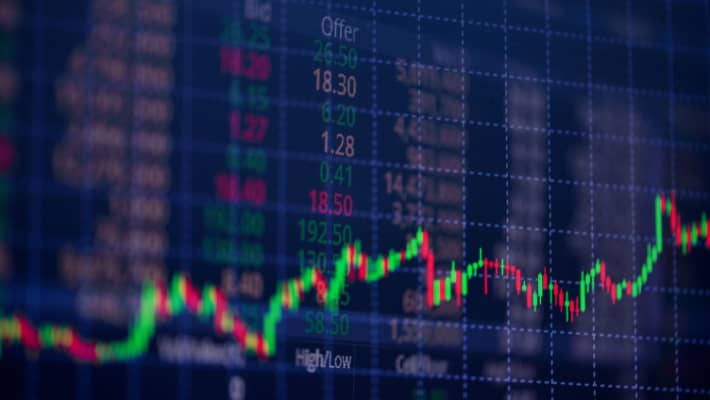Thursday Nov 23 2023 11:41

7 min

Trends play a pivotal role in guiding both short-term trading decisions and long-term investment strategies.
Yet, for many, the very concept of a trading trend remains enigmatic and elusive.
This article seeks to unravel the essence of trends in trading, offering readers a structured overview of their underlying mechanisms, and the types of trends in trading.
Trading trends, at their core, represent the discernible direction in which a security or market is moving and understanding it is fundamental to making informed trading decisions.
These movements, rather than being random, are often reflected in certain recognizable chart patterns or are indicated by technical analysis tools and indicators.
Why are these trends so essential? For traders, they serve as guiding lights. By carefully monitoring these trends, traders can identify the best moments to enter and exit their positions.
For instance, a trader might choose to buy a security when they identify the onset of an upward trend and sell when they see signs of potential reversal.
The reverse might be true for downward trends. In essence, these trends provide actionable insights and opportunities to capitalise on market movements.
However, merely spotting a current trend isn't enough. Analysing financial markets for historical patterns and behaviours is equally crucial. Why? Because markets, while influenced by a plethora of current events and data, also exhibit patterns that have repeated over time.
By studying past trends, investors garner the ability to forecast or predict how similar setups might play out in the future.
This predictive power is invaluable. It not only reduces potential risks but also empowers traders with the confidence to make decisions in a landscape that is inherently fraught with uncertainty.
Analysing past market movements, changes in asset prices and economic data can be used to identify short-term and long-term trends.
Using technical indicators such as moving averages, the MACD indicator, and stochastics can also help you spot potential trading opportunities and take advantage of prevailing market trends.
Delving into historical market movements is about more than just a backward glance; it's a detailed study of how asset prices have reacted to various economic, geopolitical, and financial stimuli over time.
By examining these past movements, one can distinguish between short-term fluctuations and more sustained, long-term trends. Such differentiation is crucial for traders who might be looking for quick gains versus investors with a longer horizon.
In addition to raw price data and economic metrics, technical analysis provides an arsenal of tools designed to highlight and interpret these patterns. Among the most revered are:
While the market's ebbs and flows might seem erratic to the untrained eye, they often conform to distinct patterns or trends.
These trends are categorised based on their duration and characteristics into three primary types: short-term, intermediate-term, and long-term.
A deep dive into each of these types offers valuable insights for any investor.
Recognizing and distinguishing between these trends is more than just a matter of academic interest.
For investors, it's a strategic imperative.
Trend trading is an investment strategy where traders aim to capitalise on market movements by identifying and taking positions based on the established direction of asset prices.
Instead of attempting to predict exact market tops or bottoms, trend traders ride the momentum of the trend for as long as it persists, using technical analysis tools to guide their entry and exit points.
In essence, the mantra of trend trading is "the trend is your friend," emphasising the importance of aligning trades with the prevailing market direction rather than going against it.
Understanding trends in trading is akin to reading the rhythmic heartbeat of the financial markets.
Whether they are short-lived blips or sustained movements spanning years, these trends offer invaluable insights for traders and investors alike.
They not only provide a historical context but also hint at future trajectories, allowing market participants to make informed decisions.
By recognizing and harnessing these patterns, one can navigate the complex terrains of the market with enhanced precision and confidence.
As the financial world continues to evolve, keeping a vigilant eye on these trends remains a timeless tool for achieving trading success.
Begin your trading adventure with markets.com, one of the top-tier CFD trading platforms tailored for novices and experienced traders alike.
You can become a member of our trading community and access a cutting-edge trading platform today.
"When considering "CFDs" for trading and price predictions, remember that trading CFDs involves a significant degree of risk and could result in capital loss. Past performance is not indicative of any future results. This information is provided for informative purposes only and should not be considered investment advice."
Risk Warning: this article represents only the author’s views and is for reference only. It does not constitute investment advice or financial guidance, nor does it represent the stance of the Markets.com platform.When considering shares, indices, forex (foreign exchange) and commodities for trading and price predictions, remember that trading CFDs involves a significant degree of risk and could result in capital loss.Past performance is not indicative of any future results. This information is provided for informative purposes only and should not be construed to be investment advice. Trading cryptocurrency CFDs and spread bets is restricted for all UK retail clients.